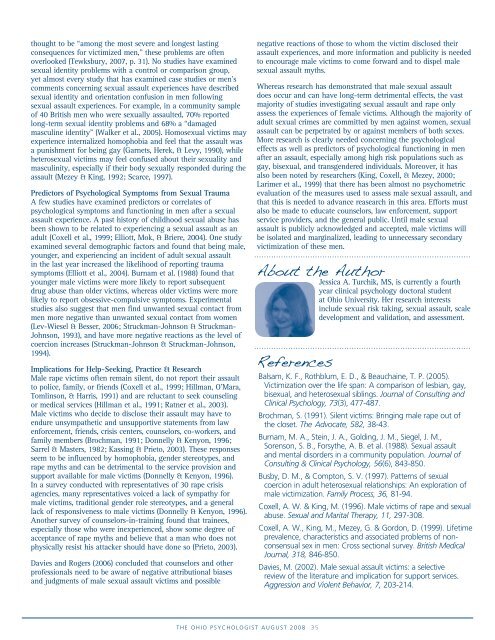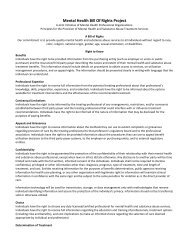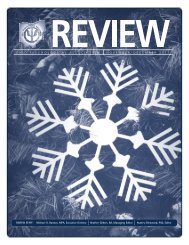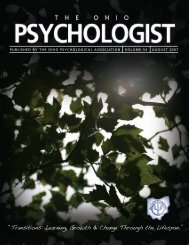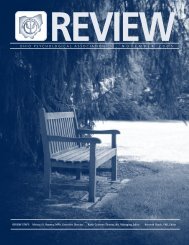2008 Ohio Psychologist - Ohio Psychological Association
2008 Ohio Psychologist - Ohio Psychological Association
2008 Ohio Psychologist - Ohio Psychological Association
Create successful ePaper yourself
Turn your PDF publications into a flip-book with our unique Google optimized e-Paper software.
thought to be “among the most severe and longest lasting<br />
consequences for victimized men,” these problems are often<br />
overlooked (Tewksbury, 2007, p. 31). No studies have examined<br />
sexual identity problems with a control or comparison group,<br />
yet almost every study that has examined case studies or men’s<br />
comments concerning sexual assault experiences have described<br />
sexual identity and orientation confusion in men following<br />
sexual assault experiences. For example, in a community sample<br />
of 40 British men who were sexually assaulted, 70% reported<br />
long-term sexual identity problems and 68% a “damaged<br />
masculine identity” (Walker et al., 2005). Homosexual victims may<br />
experience internalized homophobia and feel that the assault was<br />
a punishment for being gay (Garnets, Herek, & Levy, 1990), while<br />
heterosexual victims may feel confused about their sexuality and<br />
masculinity, especially if their body sexually responded during the<br />
assault (Mezey & King, 1992; Scarce, 1997).<br />
Predictors of <strong>Psychological</strong> Symptoms from Sexual Trauma<br />
A few studies have examined predictors or correlates of<br />
psychological symptoms and functioning in men after a sexual<br />
assault experience. A past history of childhood sexual abuse has<br />
been shown to be related to experiencing a sexual assault as an<br />
adult (Coxell et al., 1999; Elliott, Mok, & Briere, 2004). One study<br />
examined several demographic factors and found that being male,<br />
younger, and experiencing an incident of adult sexual assault<br />
in the last year increased the likelihood of reporting trauma<br />
symptoms (Elliott et al., 2004). Burnam et al. (1988) found that<br />
younger male victims were more likely to report subsequent<br />
drug abuse than older victims, whereas older victims were more<br />
likely to report obsessive-compulsive symptoms. Experimental<br />
studies also suggest that men find unwanted sexual contact from<br />
men more negative than unwanted sexual contact from women<br />
(Lev-Wiesel & Besser, 2006; Struckman-Johnson & Struckman-<br />
Johnson, 1993), and have more negative reactions as the level of<br />
coercion increases (Struckman-Johnson & Struckman-Johnson,<br />
1994).<br />
Implications for Help-Seeking, Practice & Research<br />
Male rape victims often remain silent, do not report their assault<br />
to police, family, or friends (Coxell et al., 1999; Hillman, O’Mara,<br />
Tomlinson, & Harris, 1991) and are reluctant to seek counseling<br />
or medical services (Hillman et al., 1991; Ratner et al., 2003).<br />
Male victims who decide to disclose their assault may have to<br />
endure unsympathetic and unsupportive statements from law<br />
enforcement, friends, crisis centers, counselors, co-workers, and<br />
family members (Brochman, 1991; Donnelly & Kenyon, 1996;<br />
Sarrel & Masters, 1982; Kassing & Prieto, 2003). These responses<br />
seem to be influenced by homophobia, gender stereotypes, and<br />
rape myths and can be detrimental to the service provision and<br />
support available for male victims (Donnelly & Kenyon, 1996).<br />
In a survey conducted with representatives of 30 rape crisis<br />
agencies, many representatives voiced a lack of sympathy for<br />
male victims, traditional gender role stereotypes, and a general<br />
lack of responsiveness to male victims (Donnelly & Kenyon, 1996).<br />
Another survey of counselors-in-training found that trainees,<br />
especially those who were inexperienced, show some degree of<br />
acceptance of rape myths and believe that a man who does not<br />
physically resist his attacker should have done so (Prieto, 2003).<br />
Davies and Rogers (2006) concluded that counselors and other<br />
professionals need to be aware of negative attributional biases<br />
and judgments of male sexual assault victims and possible<br />
negative reactions of those to whom the victim disclosed their<br />
assault experiences, and more information and publicity is needed<br />
to encourage male victims to come forward and to dispel male<br />
sexual assault myths.<br />
Whereas research has demonstrated that male sexual assault<br />
does occur and can have long-term detrimental effects, the vast<br />
majority of studies investigating sexual assault and rape only<br />
assess the experiences of female victims. Although the majority of<br />
adult sexual crimes are committed by men against women, sexual<br />
assault can be perpetrated by or against members of both sexes.<br />
More research is clearly needed concerning the psychological<br />
effects as well as predictors of psychological functioning in men<br />
after an assault, especially among high risk populations such as<br />
gay, bisexual, and transgendered individuals. Moreover, it has<br />
also been noted by researchers (King, Coxell, & Mezey, 2000;<br />
Larimer et al., 1999) that there has been almost no psychometric<br />
evaluation of the measures used to assess male sexual assault, and<br />
that this is needed to advance reasearch in this area. Efforts must<br />
also be made to educate counselors, law enforcement, support<br />
service providers, and the general public. Until male sexual<br />
assault is publicly acknowledged and accepted, male victims will<br />
be isolated and marginalized, leading to unnecessary secondary<br />
victimization of these men.<br />
About the Author<br />
Jessica A. Turchik, MS, is currently a fourth<br />
year clinical psychology doctoral student<br />
at <strong>Ohio</strong> University. Her research interests<br />
include sexual risk taking, sexual assault, scale<br />
development and validation, and assessment.<br />
References<br />
Balsam, K. F., Rothblum, E. D., & Beauchaine, T. P. (2005).<br />
Victimization over the life span: A comparison of lesbian, gay,<br />
bisexual, and heterosexual siblings. Journal of Consulting and<br />
Clinical Psychology, 73(3), 477-487.<br />
Brochman, S. (1991). Silent victims: Bringing male rape out of<br />
the closet. The Advocate, 582, 38-43.<br />
Burnam, M. A., Stein, J. A., Golding, J. M., Siegel, J. M.,<br />
Sorenson, S. B., Forsythe, A. B. et al. (1988). Sexual assault<br />
and mental disorders in a community population. Journal of<br />
Consulting & Clinical Psychology, 56(6), 843-850.<br />
Busby, D. M., & Compton, S. V. (1997). Patterns of sexual<br />
coercion in adult heterosexual relationships: An exploration of<br />
male victimization. Family Process, 36, 81-94.<br />
Coxell, A. W. & King, M. (1996). Male victims of rape and sexual<br />
abuse. Sexual and Marital Therapy, 11, 297-308.<br />
Coxell, A. W., King, M., Mezey, G. & Gordon, D. (1999). Lifetime<br />
prevalence, characteristics and associated problems of nonconsensual<br />
sex in men: Cross sectional survey. British Medical<br />
Journal, 318, 846-850.<br />
Davies, M. (2002). Male sexual assault victims: a selective<br />
review of the literature and implication for support services.<br />
Aggression and Violent Behavior, 7, 203-214.<br />
THE OHIO PSYCHOLOGIST AUGUST <strong>2008</strong> 35


